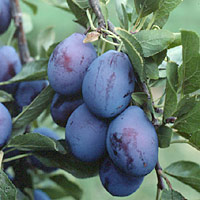
About This Plant
Some plums are self-fertile but all plums will yield better if planted with a second variety for cross-pollination. Japanese plums need to cross-pollinate with other Japanese or American hybrid plums. Order bare-root, rather than potted trees, if possible. A well-established tree will yield up to 2 bushels of plums.Site Selection
Select a site that offers loamy, well-drained soil in full sun. Avoid frost pockets.Planting Instructions
Set bare-root trees atop a small mound of soil in the center of the planting hole, and spread the roots down and away without unduly bending them. Keep the graft union an inch above the soil line. For container-grown trees, remove the plant from its pot and eliminate circling roots by laying the root ball on its side and cutting through the roots with shears. Don't cover the top of the root-ball with backfill because it could prevent water from entering. Space standard-size varieties 20 to 25 feet apart, dwarfs 15 to 20 feet apart.Care
Water young trees heavily every week through the first season. Train Japanese trees to an open center shape; train European trees to a conical shape with a central leader. Japanese plum trees benefit from a moderate fruit thinning; do not thin European plums unless the crop is especially heavy. Plums are relatively pest-free, but may be visited by the plum curculio, black knot disease, and brown rot. Contact your Cooperative Extension office for information on managing pests in your area.Harvesting
Harvest European plums when they are tree-ripe. They will be a little soft and should come off easily with a slight twist. Late maturing varieties should be near ripe with firm flesh for storing for a few weeks. Pick Japanese plums slightly early and allow them to ripen in a cool place.
ORGANİC FERTILIZERS AND PRODUCTIONS
LIQUID OR SOLID ORGANIC FERTILIZER PRODUCTION is not very complicated. For the production, there is need usable and tried a formulation, raw materials and mixing tank. For raw materials to be used, quantities to be used and ingredients usage rankings, you should look into this formulation. Therefore, formulation and productıon methods of ORGANIC FERTILIZERS are important. If you have not a good formulation, you cannot make healthy and efficient production of any fertilizer.
If you need any manufacturing formulations and production methods about
any liquid and solid organic fertilizer,
ORGANIC
FERTILIZERS
FORMULATIONS
ENCYCLOPEDİA
is enough.
This encyclopedia has many formulations about organic soil conditioner,humic acid productions,compositions,fulvic acid manufacturing,organic fertilizers,animal manure,amino acid organic fertilizers, organomineral powder fertilizers,organomineral liquid fertilizers productions,liquid root growth fertilizers formulas,granular root growth fertilizers,seaweed organic fertilizers,wermicompost fertilizers formulations,gel organic fertilizers,organomineral gel fertilizers manufacturing and any organic fertilizers etc.
All organic fertilizers in the encyclopedia are producible easily.You need no help and no technıcal support. The encyclopedia is enough to produce organic fertilizers itself.
ORGANIC
FERTILIZERS
FORMULATIONS
ENCYCLOPEDIA
is written clear and understandable.
RELATED TAGS: What is organic fertilizer,preparation of organic soil conditioner, liquid organic fertilizer manufacturing,animal manure manufacturing, manufacturing proces of animal manure,chicken manure,efficiency of humic acid in soil,effect of humic acid in plants, advantages of humic acid in agriculture, types of animal manure,seaweed fertilizer manufacturing process,production of liquid seaweed fertilizers, what is organic compost, preparation of organic compost,how to use organic compost,making organic compost, using of seaweed fertilizer,properties of seaweed organic fertilizers how to make liquid organic fertilizers, making organic compost,types of organic compost,manufacturing process of organic compost, how to make organic compost fertilizers, production of organic fertilizers,manufacturing process solid humic acid, formulation of humic acid,value of humic acid,manufacturing process of fulvic acid,how to produce humic acid,what is leoardite,where to use leonardite,types of leonardite,properties of leonardite,analyzes of leonardite,specification of leonardite, values of leonardite, what is leonardite humate,what is potassium humate, liquid humic acid preparation,powder humic acid production, granular soil conditioner manufacturing process, powder soil conditioner making,formulation of organic soil conditioner, making powder humic acid,humic acid production, composition of organic fertilizers,how to use organic fertilizers,why to use organic fertilizer,types of organic fertilizer,benefits of organic fertilizers,wermicompost fertilizers making, powder organic fertilizers,how to use organic fertilizers, making wermicompost fertilizer, formulation of seaweed fertilizers, amino acid fertilizer production,granular organic fertilizer,amino acid organic fertilizer manufacturing, properties of organic fertilizers, analyzes of organic fertilizer, specification of organic fertilizers, where to use organic fertilizers, what is soil amendments, humic acid making, how to make powder humic acid, manufacturing process of fulvic acid, herbal fulvic acid making, liquid humic acid process, formulation of humic acid,organic fertilizers for plants, organic fertilizers in agriculture, how to produce organic fertilizers, animal manure manufacturing process, herbal fertilizers, what is organic fertilizer compost, what is organic agriculture, how to make organic agriculture, advantages of organic fertilizers, effects of organic fertilizer, results of organic fertilizers, indications of organic fertilizers, symptoms of organic fertilizers, preparation of organic fertilizers, calculation of organic fertilizers, compounds of organic fertilizers,composition of liquid organic fertilizers, fertilization of organic fertilizers,why to use organic fertilizers.what is humate, types of humates,benefit of humate,potassium humate manufacturing process.,using powder soil conditioner, properties of granular soil conditioner,what is pellet organic soil conditioner.what is amino acid fertilizer, how to use organic amino acid fertilizsers,making amino acid fertilizers,formulation of amino acid fertilizers,manufacturing process of amino acid fertilizers, what is organic compost, where to use organic compost, types of organic compost in plants,benefits of organic compost in soil, preparation of organic compost in agriculture.
AGRICULTURE ENCYCLOPEDIAS AND CONTENTS


E - BOOKS AND HARD BOOKS

HOW TO BUY
AGRICULTURE ENCYCLOPEDIAS AND VIDEOS


E - BOOKS AND HARD BOOKS

HOW TO BUY
AGRICULTURE ENCYCLOPEDIAS AND VIDEOS
|
|
|
|
|
|
|
|
|
